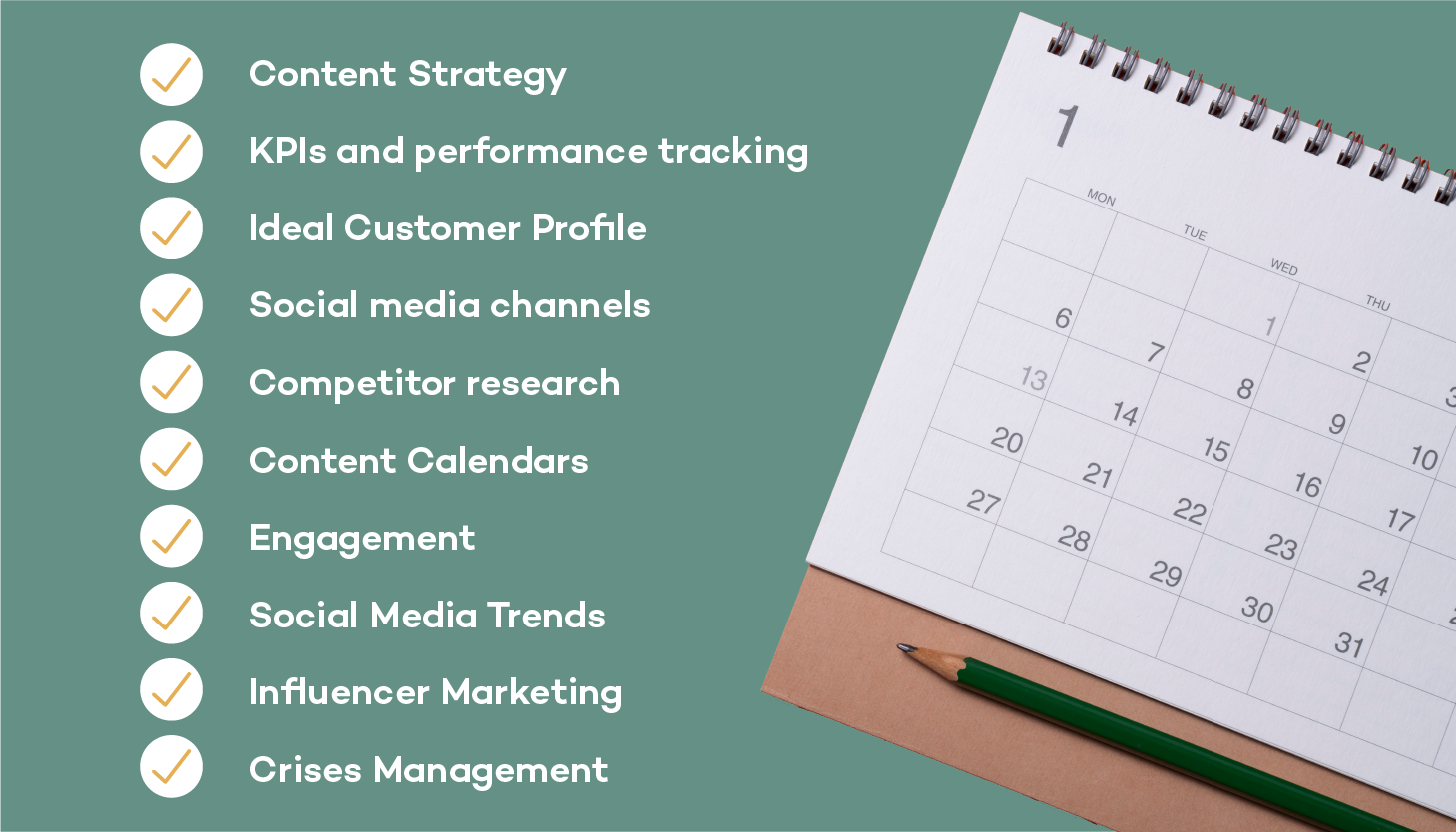The Bare Minimum Social Media Plan You Need for Success
When it comes to social media marketing, there are probably more creative ideas than skilled social media marketers to implement them. And reading this, you’re probably picturing some stunning commercial or publicity stunt you’ve seen a big brand pull off on social media.
Now, let’s be honest here — the complicated, super-creative stuff works, (which is probably why you remember it anyway!) But you can equally pull a ton of marketing weight by simply performing your basics on a consistent and regular basis.
Wondering why? As far as marketing goes, it’s not the one-off strokes of marketing genius that get you results. The bread-and-butter, foundational activity that you perform — and can iterate for even better results and scale creatively — is the real game-changer.
In the spirit of embracing the simple stuff, we’ll outline the structure of a social media plan. We’ll also drill down on how you can leverage one with minimum fuss while getting the best returns on marketing efforts and spend.
A good place to start will be to understand the social media strategy cycle.
What is social media strategy cycle?

Think of the social media strategy cycle as a process that helps you draw up and implement an effective social media strategy.
The cycle includes four steps — planning, execution, monitoring, and evaluation. By following this process, you can ensure that your social media effort is aligned with your business goals and objectives.
— The first step in the cycle is planning.
This phase helps you map out and clearly define your social media goals and objectives. You should also identify the target audience for your social media efforts. In addition, you should determine what content you will share on social media.
— The second step in the cycle is execution.
Here, you should create and implement a social media plan. This plan should include a schedule for posting content, as well as a strategy for engagement. Additionally, consider how to measure the success of your social media efforts.
— The third step in the cycle is monitoring.
Here’s where you track their social media metrics. This stage also requires you to regularly review your social media plan to ensure that it is still effective. Additionally, you want to respond to any negative feedback you receive on social media.
— The fourth and final step in the cycle is evaluation.
During this phase, you should assess the results of your social media efforts. You should also identify any areas for iterations or improvement.
What should a social media plan include?

Content Strategy
A social media plan should include a strategy for how you will use social media to achieve your business goals. This strategy should be based on an understanding of your target audience, your goals, and the unique strengths of each social media platform.
You are then required to build your content around this strategy. To gain the attention that you need to build and maintain an audience, you need to constantly create and share content. It could be blog posts, infographics, explainer videos, tweets, or even memes!
But while content creation is just one aspect; curation is another. Nobody wants to engage with multiple social media posts that toot your company’s horn only. But by extending your content to include other topics which, although they don’t directly shill your business, are of interest to your audience.
KPIs and performance tracking
In drawing up a strategy, you need to outline your goals and then specify the KPIs with which you intend to measure your progress. These might include content engagement metrics and sales conversion rates.
Ideal Customer Profile
Different products have different audiences. To illustrate, while a company that produces golf clubs will need to target working-class adults in their middle ages or older, a skatewear company might achieve greater profitability by targeting teenagers.
Identifying your ideal audience is another crucial part of social marketing. So, based on what your product is and who your likely customers are, draw up an ideal customer profile.
Social media channels
With a swell of social media channels, it’s practically impossible to build a presence on every single one. What you can do is identify channels where your ideal audience is more likely to be found and ‘set up shop’ on them.
Competitor research
Everyone’s on social media these days—including your competitors. And researching their activity should be a vital part of your social media plan.
By tracking their activity, you can identify what they are doing right to emulate them and improve on them. You can also identify gaps in their strategy, and then tailor yours to snag the competitive advantage.
Content calendars
This calendar should be tailored to your content strategy and should take into account things like holidays, events, and product launches.
Posting periodically can help rocket your brand’s awareness in the minds of your audience. And when there’s a pattern to it, they respond even more favourably. To borrow from Pavlov’s famous experiment, we are more likely to respond positively to stimuli (or social media posts, in this case) when we’ve been conditioned to expect them.
Using readily available data on user patterns, you can identify time periods where members of your ideal audience are more likely to be active online and then draw up a content calendar to plan out your social media activity targeting those times.
Engagement
Since social media algorithms are designed to prioritise content based on relevance, they tend to rank posts based on engagement metrics. This is why engagement tactics must be part of any social media plan. You can directly stimulate engagement by asking your audience to comment or share their own stories.
Also, you need to like their comments and respond to them. It signals to the algorithm that there’s healthy engagament going on.
Social media trends
There is always something trending on social media, some of them socially and politically sensitive (think minority or LGBTQ rights), and others mundane (Will Smith memes, for example). You can hardly predict what will trend, or when it will happen. But what you can do is create a framework to participate in these trends.
For LGBTQ rights, you might want to situate the pride flag somewhere in your social media profile and restate your company’s commitment to equal rights. And for the mundane stuff, you can simply join the party by creating and sharing hilarious memes.
However, bear in mind that you don’t need to force marketing messages into these memes; it shows and can appear cringy. Just aim to elicit a laugh, and the rest will sort itself out; virality is publicity on its own.
Influencer marketing
Even with the best social media management, sometimes it can be unlikely to generate heightened buzz from posting from just one account. This is where influencer marketing has increasingly become an essential part of social media plans.
By paying a few people (usually social media sensations or influencers) to communicate your message to their audiences, you can amplify your brand’s voice and message.
To do this, you can’t bring on just anybody with a few thousand followers on their accounts. Some due diligence must be done before you select influencers. You need to be sure that whoever you choose has organically cultivated their audience. And the easiest way to check for this is to see how their followers interact with their posts.
Also, people are very sensitive to being sold to and can quickly go on the defensive. However, by selecting influencers whose content niche aligns with your product, you can be sure that your message would be passed to their audience more organically.
Crises management
Social media managers are human, and every now and then, gaffes happen. Posts might be considered offensive by segments of your audience or might just be ill-timed. Other times, it might just be a flood of poor reviews from cust at other timesomers. For all these scenarios, you must draw up plans to intercept the situation and minimize damage.
Maximise your bare minimum with Apsis One
Social media marketing is a modern miracle for businesses. You can organically generate buzz and achieve greater conversion rates for less than a fraction of the amount spent on traditional ad media.
However, unlike TV where you always get the airtime paid for, social media is a bit more tricky. Your marketing message could easily get lost in the noise without the right strategy. A social media plan that includes our baseline tips can help you increase your chances of social media marketing success a thousandfold.
Apsis One’s social media marketing tools help you fully leverage the social media behaviour of your audiences using rich, segmented data, allowing you to create successful social media marketing campaigns.
We’re all about partnering you with comprehensive marketing solutions to help you properly nurture and integrate all aspects of your marketing — and that includes your social media marketing.
Ready to get started? Snap up our content calendar for free here. To get a full glimpse of the experience, book a demo today.


